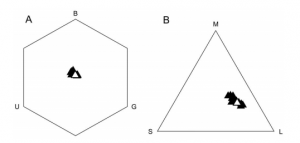
Orchid Mantis
He loves me… He loves me not… As you peel the petals off your flowers this Valentine’s Day, it may be important to ensure that it’s not an orchid mantis. Floral mimicry is most commonly found in orchids, where approximately a third of the species depend on deception for pollination. Until now, there has not been any documented case of floral mimicry occurring outside of angiosperms.
Orchid mantises are elusive creatures and are hypothesized to use floral mimicry as a means to attract pollinators as prey. Hanlon et al. (2014) applied color modeling to compare orchid mantis and flower coloration from the perspective of a hypothetical pollinator. Then, observation of behavioral responses of wild pollinators to live orchid mantises were used to test the hypothesis that the orchid mantis is a flower mimic.

Average color coordinates of orchid mantises are in the filled triangles, while the color coordinates of 13 wild flower species are shown in open triangles.
Hanlon et al. (2014) used two separate models of trichromatic hymenopterian vision: the color hexagon and the receptor noise limited model. Their results showed that the colors of orchid mantises fall within the range of flower petal colors of numerous local flowers, and the average chromatic contrast values between orchid mantises and 13 flower species were either significantly below or not significantly different from the discrimination threshold values of honeybees.
In field experiments, Hanlon et al. (2014) found that visitation rates per-hour differed between the flower, the mantis, and the bare stick control. Wild pollinating insects, primarily bees but occasionally butterflies and flies, inspected the live juvenile female orchid mantises significantly more frequently than the bare stick. Hanlon et al. (2014) recorded two successful prey captures as well as numerous prey capture attempts by the orchid mantises; their prey capture attempts did not deter pollinating insects from inspecting and visiting the orchid mantises.
This study by Hanlon et al. (2014) confirms the mimicry hypothesis of orchid mantises: floral mimicry, in the orchid mantis, is used to attract pollinators as prey. While many species use floral camouflage to catch prey, the orchid mantis uses a more aggressive form of mimicry; pollinators are deceived and attracted to the orchid mantis rather than flowers within the general vicinity. The orchid mantis provides some of the first evidence for floral mimicry as a predatory strategy.
For more information, here’s a neat BBC Earth video on the orchid mantis: https://www.youtube.com/watch?v=FUKyETJZqM8
Hanlon, J., Holwell, G., Herberstein, M. (2014). Pollinator deception in the orchid mantis. The American Naturalist 183:1, 126-132


That video is very cool!